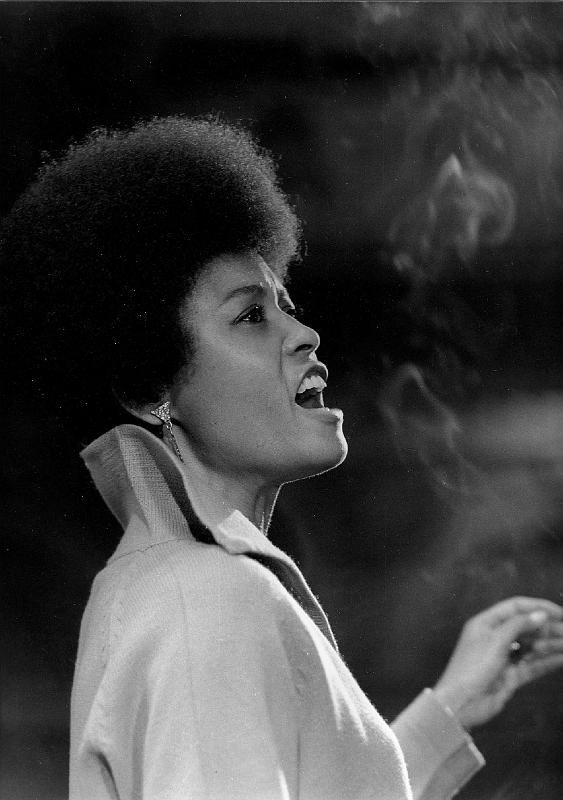Abbey Lincoln, Jazz Singer and Writer, Dies at 80
By NATE CHINEN
Published: August 14, 2010
Abbey Lincoln, a singer whose dramatic vocal command and tersely poetic songs made her a singular figure in jazz, died on Saturday in Manhattan. She was 80 and lived on the Upper West Side.
Chester Higgins Jr./The New York Times
Singer-composer Abbey Lincoln at her home in Manhattan in 2002.
Her death was announced by her brother David Wooldridge.
Ms. Lincoln’s career encompassed outspoken civil rights advocacy in the 1960s and fearless introspection in more recent years, and for a time in the 1960s she acted in films, including one with Sidney Poitier.
Long recognized as one of jazz’s most arresting and uncompromising singers, Ms. Lincoln gained similar stature as a songwriter only over the last two decades. Her songs, rich in metaphor and philosophical reflection, provide the substance of “Abbey Sings Abbey,” an album released on Verve in 2007. As a body of work, the songs formed the basis of a three-concert retrospective presented by Jazz at Lincoln Center in 2002.
Her singing style was unique, a combined result of bold projection and expressive restraint. Because of her ability to inhabit the emotional dimensions of a song, she was often likened to Billie Holiday, her chief influence. But Ms. Lincoln had a deeper register and a darker tone, and her way with phrasing was more declarative.
“Her utter individuality and intensely passionate delivery can leave an audience breathless with the tension of real drama,” Peter Watrous wrote in The New York Times in 1989. “A slight, curling phrase is laden with significance, and the tone of her voice can signify hidden welts of emotion.”
She had a profound influence on other jazz vocalists, not only as a singer and composer but also as a role model. “I learned a lot about taking a different path from Abbey,” the singer Cassandra Wilson said. “Investing your lyrics with what your life is about in the moment.”
Ms. Lincoln was born Anna Marie Wooldridge in Chicago on Aug. 6, 1930, the 10th of 12 children, and raised in rural Michigan. In the early 1950s, she headed west in search of a singing career, spending two years as a nightclub attraction in Honolulu, where she met Ms. Holiday and Louis Armstrong. She then moved to Los Angeles, where she encountered the accomplished lyricist Bob Russell.
It was at the suggestion of Mr. Russell, who had become her manager, that she took the name Abbey Lincoln, a symbolic conjoining of Westminster Abbey and Abraham Lincoln. In 1956, she made her first album, “Affair ... a Story of a Girl in Love” (Liberty), and appeared in her first film, the Jayne Mansfield vehicle “The Girl Can’t Help It.” Her image in both cases was decidedly glamorous: On the album cover she was depicted in a décolleté gown, and in the movie she sported a dress once worn by Marilyn Monroe.
For her second album, “That’s Him,” released on the Riverside label in 1957, Ms. Lincoln kept the seductive pose but worked convincingly with a modern jazz ensemble that included the tenor saxophonist Sonny Rollins and the drummer Max Roach. In short order she came under the influence of Mr. Roach, a bebop pioneer with an ardent interest in progressive causes. As she later recalled, she put the Monroe dress in an incinerator and followed his lead.
The most visible manifestation of their partnership was “We Insist! Max Roach’s Freedom Now Suite,” issued on the Candid label in 1960, with Ms. Lincoln belting Oscar Brown Jr.’s lyrics. Now hailed as an early masterwork of the civil rights movement, the album radicalized Ms. Lincoln’s reputation. One movement had her moaning in sorrow, and then hollering and shrieking in anguish — a stark evocation of struggle. A year later, after Ms. Lincoln sang her own lyrics to a song called “Retribution,” her stance prompted one prominent reviewer to deride her in print as a “professional Negro.”
Ms. Lincoln, who married Mr. Roach in 1962, was for a while more active as an actress than a singer. In 1964 she starred with Ivan Dixon in “Nothing but a Man,” a tale of the Deep South in the 1960s, and in 1968 she was the title character opposite Mr. Poitier in the romantic comedy “For Love of Ivy,” playing a white family’s maid. She also acted on television in guest-starring roles in the ’60s and ’70s.
But with the exception of “Straight Ahead” (Candid), on which “Retribution” appeared, she released no albums in the 1960s. And after her divorce from Mr. Roach in 1970, she took an apartment above a garage in Los Angeles and withdrew from the spotlight for a time. She never remarried.
In addition to Mr. Wooldridge, Ms. Lincoln is survived by another brother, Kenneth Wooldridge, and a sister, Juanita Baker.
During a visit to Africa in 1972, Ms. Lincoln received two honorary appellations from political officials: Moseka, in Zaire, and Aminata, in Guinea. (Moseka would occasionally serve as her surname.) She began to consider her calling as a storyteller and focused on writing songs.
Moving back to New York in the 1980s, Ms. Lincoln resumed performing, eventually attracting the attention of Jean-Philippe Allard, a producer and executive with PolyGram France. Ms. Lincoln’s first effort for what is now the Verve Music Group, “The World Is Falling Down” (1990), was a commercial and critical success.
Eight more albums followed in a similar vein, each produced by Mr. Allard and enlisting top-shelf jazz musicians like the tenor saxophonist Stan Getz and the vibraphonist Bobby Hutcherson. In addition to elegant originals like “Throw It Away” and “When I’m Called Home,” the albums featured Ms. Lincoln’s striking interpretations of material ranging from songbook standards to Bob Dylan’s “Mr. Tambourine Man.”
For “Abbey Sings Abbey” Ms. Lincoln revisited her own songbook exclusively, performing in an acoustic roots-music setting that emphasized her affinities with singer-songwriters like Mr. Dylan. Overseen by Mr. Allard and the American producer-engineer Jay Newland, the album boiled each song to its essence and found Ms. Lincoln in weathered voice but superlative form.
When the album was released in May 2007, Ms. Lincoln was recovering from open-heart surgery. In her Upper West Side apartment, surrounded by her own paintings and drawings, she reflected on her life, often quoting from her own song lyrics. After she recited a long passage from “The World Is Falling Down,” one of her more prominent later songs, her eyes flashed with pride. “I don’t know why anybody would give that up,” she said. “I wouldn’t. Makes my life worthwhile.”
=======================
Abbey Lincoln's Emancipation Proclamation

Abbey Lincoln at Carnegie Hall in 2004.
"I HAD a chance to be myself, and I was,” Abbey Lincoln said one recent afternoon, in a corner parlor of her spacious but unassuming ground-floor apartment on the Upper West Side of Manhattan. This 76-year-old jazz legend was summing up her new album, “Abbey Sings Abbey” (Verve), but she could have been describing the central theme of her long and colorful career. On the walls around her were dozens of artifacts — photographs of her with jazz greats, plaques from politicians and family portraits she painted — attesting to the fullness of that story. Dominating the room was a piano, the instrument with which she wrote many of her symbolically charged and self-reflective songs.
Multimedia
Ms. Lincoln was on the mend from recent open-heart surgery, which might nudge anyone toward rumination. But sitting on a couch in loose clothing, she was as matter-of-fact about her health as she is about her work. Long recognized as one of jazz’s most arresting and uncompromising singers, she has more recently been celebrated as a gifted lyricist and composer. She is the rare jazz singer who writes her own songs, and the rare jazz songwriter whose music conveys the lessons of her life, like, “You can never lose a thing if it belongs to you.”
“Abbey Sings Abbey,” which is out on Tuesday, captures the depth of her art with majestic serenity and bittersweet clarity. As the title suggests, it looks back on her original songs, the first time Ms. Lincoln has dedicated a full album to her own work. Another first: It surrounds her richly textured voice with acoustic and pedal steel guitars, accordion and mandolin, in an American roots-music style. “For some reason,” she said, “it’s better than anything I’ve done before.”
And Ms. Lincoln — who was born Anna Marie Wooldridge, the 10th of 12 children — has done quite a lot in her five-decade-plus career. Her songs are almost certainly her proudest achievement, an impression she reinforces by quoting them liberally, and commandingly, in conversation. “I’m a philosopher, you know,” she said, several minutes into an interview marked at first by wariness, then candor and humor. She frequently reached back into her history, reminiscing even about the things she’s glad to have left behind.
Fifty years ago Ms. Lincoln was on track to become a film and cabaret siren, appearing in the Jayne Mansfield movie “The Girl Can’t Help It,” and on the cover of her 1956 debut, “Affair ... Story of a Girl in Love,” in a décolleté dress and a come-hither pose. She had already spent two years in Honolulu as a supper-club attraction. “I was a glamour queen there too,” she said, smiling faintly. “I met Louis Armstrong, Billie Holiday. I’d do my show and run to see Billie. She’d stand on the stage and never move, except for her eyes.”
Ms. Lincoln would eventually be hailed as a successor to Holiday, for her interpretive prowess as well as a slight resemblance between their grainy yet supple vocal timbres. But that accolade was well beyond the horizon when she left Hawaii for Los Angeles, where she met the lyricist Bob Russell, who became her manager. “One time he told me, ‘SinceAbraham Lincoln didn’t free the slaves, maybe you could handle it,’ ” she recalled with a laugh. “He named me Abbey Lincoln.”
Emancipation became a genuine preoccupation for Ms. Lincoln after she met Max Roach, the maverick bebop drummer she credits with “helping me find myself”; they married in 1962. In New York Mr. Roach brought her into his world of artistic experimentation and political engagement. Ms. Lincoln cut herself loose from her satiny image. She’s fond of recalling the emblematic moment when she burned the dress she sported in “The Girl Can’t Help It,” which had previously been worn by Marilyn Monroe. By 1960 she was vocalizing with a raw, spine-tingling power in Mr. Roach’s “We Insist! Freedom Now Suite,” a momentous civil-rights anthem.
In 1961 Ms. Lincoln made some early forays into lyric writing on an album called “Straight Ahead” (Candid) that sparked a public discussion about racial prejudice in jazz, after one reviewer derided Ms. Lincoln as a “professional Negro.” She seems to view those tensions now in an almost clinical light. “People remember you for what you stood for,” she said simply. “And if you didn’t stand for anything, they remember that too.”
One song Ms. Lincoln versified on “Straight Ahead” was “Blue Monk,” by the pianist Thelonious Monk, who stopped by the recording studio to bestow his blessing. “He whispered in my ear just as he was leaving, ‘Don’t be so perfect,’ ” she said. That bit of advice has stayed with her over the years. “Blue Monk” opens the new album.
It wasn’t until her 40s that Ms. Lincoln began to come into her own as a composer. After her divorce from Mr. Roach in 1970, she withdrew from the spotlight, taking an apartment above a garage in Los Angeles. She released an album after a revelatory trip to Africa in 1972, but otherwise directed most of her energies inward. Her songs reflected that spirit of introspection. “I got some people in me,” she wrote.
Moving back to New York in the 1980s she resumed performing, eventually attracting the attention of Jean-Philippe Allard, a producer and executive with Polygram France. Ms. Lincoln’s first effort for what is now the Verve Music Group, “The World Is Falling Down” in 1990, was a commercial and critical success and eight more albums followed, each involving elite jazz musicians and refined jazz arrangements.
The new album purposefully departs from that formula. Mr. Allard, speaking from Paris, said that he and Jay Newland, the engineer on almost all of those Verve releases, had long shared a quiet conviction. “Abbey’s songs have this folk element that is not well represented in a jazz context sometimes,” he said.
Multimedia
Mr. Newland, who produced “Abbey Sings Abbey” with Mr. Allard, traces the concept for the album back at least a decade, to a recording Ms. Lincoln made of Bob Dylan’s “Mr. Tambourine Man.” She’s a singer-songwriter too, Mr. Newland recalled thinking at the time.
The idea was rekindled last year, when the producers worked together on an album by the Afro-European pop singer Ayo. Among the songs they recorded was Ms. Lincoln’s “And It’s Supposed to Be Love,” in a new arrangement driven by the guitarist (and as it happens, former Dylan sideman) Larry Campbell. Mr. Campbell was tasked with paring down a number of Ms. Lincoln’s other songs, in preparation for a recording session.
“I was a little skeptical,” Mr. Campbell said by cellphone, driving near Nashville. “How do you take all these really sophisticated harmonic structures and break them down to virtually folk songs?”
It turned out to be easy once he was in the studio with the versatile jazz bassist Scott Colley and the prolific rock drummer Shawn Pelton. Many of Ms. Lincoln’s songs employ a verse-chorus structure more in line with folk songs than jazz standards; some, like “The Music Is the Magic,” resemble nursery rhymes. Though the three musicians had never worked together before, they quickly devised a gently twangy atmosphere for the songs. Later the arranger Gil Goldstein fleshed out some tracks, adding his own deft accordion lines, along with parts for a cellist, Dave Eggar.
Ms. Lincoln exudes a powerful authority throughout the album, whether striking a quietly wistful note on “Should’ve Been” or appealing to a distant creator in “Down Here Below.” Her flickering alto sounds ratified by age; her phrasing is subtle and sure.
“I’ve got about 15 years on some of the songs, so it’s supposed to be a little different,” she said. “If I was imitating myself, that would be pitiful.”
Many more singers are likely to mine Ms. Lincoln’s songs, given that “Abbey Sings Abbey” presents them so clearly, and with so few adornments. Earlier this year the jazz vocalist Kendra Shank released “A Spirit Free: Abbey Lincoln Songbook” (Challenge). Her advice to any artist would be “to sing your own song,” Ms. Lincoln said. “Don’t look to me, look to yourself.” Still, she noted with evident satisfaction a report she had received: a couple of nights earlier, a singer in a club had been pressured by an audience member into singing “Throw It Away,” one of her signature songs.
The singer was Cassandra Wilson, who recorded the song on a recent album, and who has often worked with the rootsy instrumentation now being used by Ms. Lincoln. “I learned a lot about taking a different path from Abbey,” Ms. Wilson said. “Investing your lyrics with what your life is about in the moment.”
That includes the tougher moments, of which Ms. Lincoln has lately had a few. Sitting on her couch, surrounded by the totems of her life, she repeatedly admitted to a lingering fatigue. “I didn’t come here to stay forever, I know that,” she said. “So if they want to bring me home, I’ll be glad to go. It’s easy for me to say it, but I mean it too.” She has vague plans to bequeath her apartment to the community as an arts center: Moseka House, after the name she was given 35 years ago by an official in Zaire.
Of course her greatest legacy will be her music, which she isn’t ready to relinquish. “They’re my songs, and I sang ’em and I’ll sing ’em,” she said. “It’s not the last time I’ll sing ’em, either.” In August she will headline both days of the 15th Annual Charlie Parker Jazz Festival, which takes place in Harlem and the East Village.
“All along the way there were things to do/always some other someone I could be,” Ms. Lincoln said, citing lines from “Being Me,” which closes the album with a rumination on her lifelong search for an honest self. “Abbey Sings Abbey” is the manifestation of that search, a study in gravity and wisdom that could only have come, one suspects, at this point in her career.
“I should be excellent by now,” Ms. Lincoln said. “Otherwise, when is it going to be?” She drew herself up into a regal posture, grinning mischievously. “I’m baaaaaad.”
>via: http://www.nytimes.com/2007/05/20/arts/music/20chin.html?pagewanted=1&fta=y
============================

GO HERE FOR TERRY HOWCOTT'S ABBEY LINCOLN TRIBUTE FEATURING 26 VIDEOS!!!
============================

GO HERE AND HERE FOR NEO•GRIOT ABBEY LINCOLN VIDEO POSTINGS
















